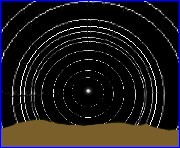|
We received this question from a visitor to our site: "Is there a 'South Star'? In other words, is there a star equivalent to the North Star, that the south pole points to, to guide travellers in the southern hemisphere?"  The North Star, or pole star, is a star called Polaris. You can find it by locating the Big Dipper, and looking for the two stars on the far side of the 'dipper'. The line these two stars make points upwards to a single star, which is the North Star Polaris. The North Star, or pole star, is a star called Polaris. You can find it by locating the Big Dipper, and looking for the two stars on the far side of the 'dipper'. The line these two stars make points upwards to a single star, which is the North Star Polaris. Did you know that the Big Dipper isn't really a constellation? It's an asterism, which is a special, recognizable group of stars. It's part of a bigger group, Ursa Major, which is a constellation. Ursa Major represents a big bear, and was named by the Romans. The handle of the Big Dipper represents the bear's tail; the cup is the bear's side. The star Polaris is in another constellation called the 'Little Bear', or Ursa Minor. It was the first star named in that constellation, so is also referred to as Alpha Ursae Minoris. As the earth spins on its axis, once every 24 hours, the stars in the sky seem to move around the earth. If you could follow them as they turn through the sky, you would notice that Polaris does not appear to move.  This is evident on long exposure photographs made at night; the stars form circular paths around the sky, as the earth turns, with Polaris in the centre of the circles, unmoving. Polaris is in the same direction as the north pole of the earth, so following the North Star will lead you toward the north. Its height above the horizon, in degrees, is also your latitude. (See our page about the north pole for an explanation). Why does Polaris lead you toward the north pole of the earth?  Here's the same picture as above, turned on its side. The north rotational pole of the earth points toward Polaris. But this star is 300 light years from Earth, or about 3000 trillion kilometres, or 3,000,000,000,000,000 km. This distance is so large that, as far as we on the surface of the earth (point A) are concerned, it's at infinity. In other words, the line of sight to Polaris from a person at  Did you know that Polaris has not always been the 'North Star', and won't be, in the future? The Earth spins on its axis just like a gyroscope, and 'precesses' as it spins. The rotational axis slowly changes direction, in a circle, over thousands of years. Currently it points within one degree of Polaris. During the past 5000 years the axis has pointed at the star Thuban (Alpha Draconis); in the year 7500 the North Star will be Alpha Cephei; in the year 15,000 it will be the star Vega. About 9000 years after that, Polaris will again become the North Star. Did you know that Polaris has not always been the 'North Star', and won't be, in the future? The Earth spins on its axis just like a gyroscope, and 'precesses' as it spins. The rotational axis slowly changes direction, in a circle, over thousands of years. Currently it points within one degree of Polaris. During the past 5000 years the axis has pointed at the star Thuban (Alpha Draconis); in the year 7500 the North Star will be Alpha Cephei; in the year 15,000 it will be the star Vega. About 9000 years after that, Polaris will again become the North Star.
Now it's time to answer the original question, which was whether there is a corresponding star in the skies of the southern hemisphere that travellers can use to find due south. There is ... sort of. It's Polaris Australis, the star Sigma Octantis, which is 25 times fainter than Polaris, hard to see with the naked eye, and as a result is not well known. The two polar stars share similar offsets from their respective poles, Polaris at 3/4 degree, Sigma at just over a full degree. As a result of precession (the 26,000 year wobble of the Earth's axis), Polaris is getting closer to the North Celestial Pole, while Sigma Octantis is moving away. |